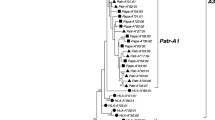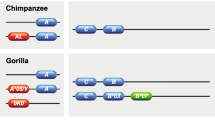Abstract
We performed a meta-analysis of the newly assembled Komodo dragon (Varanus komodoensis) genome to characterize the major histocompatibility complex (MHC) of the species. The MHC gene clusters of the Komodo dragon are gene dense, complex, and contain counterparts of many genes of the human MHC. Our analysis identified 20 contigs encompassing ~ 6.9 Mbp of sequence with 223 annotated genes of which many are predicted orthologs to the genes of the human MHC. These MHC contigs range in size from 13.2 kb to 21.5 Mbp, contain an average of one gene per 30 kb, and are thought to occur on at least two chromosomes. Eight contigs, each > 100 kb, could be aligned to the human MHC based on gene content, and these represent gene clusters found in each of the recognized mammalian MHC subregions. The MHC of the Komodo dragon shares organizational features of other non-mammalian taxa. Multiple class Iα and class IIβ genes are indicated, with linkage between classical class I and immunoproteasome genes and between framework class I genes and genes associated with the mammalian class III subregion. These findings are supported in both Komodo genome assemblies and provide new insight into the MHC organization of these unique squamate reptiles.




Similar content being viewed by others
References
Alfoldi J, Di Palma F, Grabherr M et al (2011) The genome of the green anole lizard and a comparative analysis with birds and mammals. Nature 477:587–591
Amadou C (1999) Evolution of the Mhc class I region: the framework hypothesis. Immunogenetics 49:362–367
Balakrishnan CN, Ekblom R, Völker M, et al (2010) Gene duplication and fragmentation in the zebra finch major histocompatibility complex. BMC Biol 8:29
Belov K, Deakin JE, Papenfuss AT et al (2006) Reconstructing an ancestral mammalian immune supercomplex from a marsupial Major Histocompatibility Complex. PLoS Biol 4:317–328
Bermejo-Jambrina M, Eder J, Helgers LC et al (2018) C-type lectin receptors in antiviral immunity and viral escape. Front Immunol 9:590
Bishop BM, Juba ML, Russo PS et al (2017) Discovery of novel antimicrobial peptides from Varanus komodoensis (Komodo dragon) by large-scale analyses and de-novo-assisted sequencing using electron-transfer dissociation mass spectrometry. J Proteome Res 16:1470–1482
Briles WE, Goto RM, Auffray C, Miller MM (1993) A polymorphic system related to but genetically independent of the chicken major histocompatibility complex. Immunogenetics 37:408–414
Brown GD, Willment JA, Whitehead L (2018) C-type lectins in immunity and homeostasis. Nat Rev Immunol 18:374–389
Campbell RD, Trowsdale J (1993) Map of the human MHC. Immunol Today 14:349–352
Ciofi C (1999) The Komodo dragon. Sci Am 280:84–91
Dijkstra J, Katagiri T, Hosomichi K et al (2007) A third broad lineage of major histocompatibility complex (MHC) class I in teleost fish; MHC class II linkage and processed genes. Immunogenetics 59:305–321
Dijkstra JM, Grimholt U, Leong J, Koop BF, Hashimoto K (2013) Comprehensive analysis of MHC class II genes in teleost fish genomes reveals dispensability of the peptide-loading DM system in a large part of vertebrates. BMC Evol Biol 13:260
Edwards JH (1991) The Oxford grid. Ann Hum Genet 55:17–31
Flajnik MF, Kasahara M, Shum BP, Salter-Cid L, Taylor E, Du Pasquier L (1993) A novel type of class I gene organization in vertebrates: a large family of non-MHC-linked class I genes is expressed at the RNA level in the amphibian Xenopus. Embo J 12:4385–4396
Fujita T, Matsushita M, Endo Y (2004) The lectin-complement pathway–its role in innate immunity and evolution. Immunol Rev 198:185–202
Glaberman S, Moreno MA, Caccone A (2009) Characterization and evolution of MHC class II B genes in Galapagos marine iguanas (Amblyrhynchus cristatus). Dev Comp Immunol 33:939–947
Harris RS (2007) Improved pairwise alignment of genomic DNA. Ph.D. Thesis, The Pennsylvania State University
Hanson BA (2020) HiveR: 2D and 3D Hive Plots for R. R package version 0.3.63
Holt C, Yandell M (2011) MAKER2: an annotation pipeline and genome-database management tool for second-generation genome projects. BMC Bioinformatics 12:491
Horton R, Wilming L, Rand V et al (2004) Gene map of the extended human MHC. Nat Rev Genet 5:889–899
Jaratlerdsiri W, Deakin J, Godinez RM et al (2014) Comparative genome analyses reveal distinct structure in the saltwater crocodile MHC. PLoS One 9:e114631
Jurka J, Kapitonov VV, Kohany O, Jurka MV (2007) Repetitive sequences in complex genomes: structure and evolution. Annu Rev Genomics Hum Genet 8:241–259
Kasahara M, Hayashi M, Tanaka K et al (1996) Chromosomal localization of the proteasome Z subunit gene reveals an ancient chromosomal duplication involving the major histocompatibility complex. Proc Natl Acad Sci USA 93:9096–9101
Kasahara M, Nakaya J, Satta Y, Takahata N (1997) Chromosomal duplication and the emergence of the adaptive immune system. Trends Genet 13:90–92
Katsanis N, Fitzgibbon J, Fisher EM (1996) Paralogy mapping: identification of a region in the human MHC triplicated onto human chromosomes 1 and 9 allows the prediction and isolation of novel PBX and NOTCH loci. Genomics 35:101–108
Kaufman J (2018) Unfinished business: Evolution of the MHC and the adaptive immune system of jawed vertebrates. Annu Rev Immunol 36:383–409
Kaufman J, Milne S, Göbel T et al (1999) The chicken B locus is a minimal essential major histocompatibility complex. Nature 401:923–925
Kobari F, Sato K, Shum BP et al (1995) Exon-intron organization of Xenopus MHC class II β chain genes. Immunogenetics 42:376–385
Kjer-Nielsen L, Patel O, Corbett AJ et al (2012) MR1 presents microbial vitamin B metabolites to MAIT cells. Nature 491:717–723
Klein J (1986) Seeds of time: Fifty years ago Peter A. Gorer discovered the H-2 complex. Immunogenetics 24:331–338
Korf I (2004) Gene finding in novel genomes. BMC Bioinformatics 5:59
Kulski J, Gaudieri S, Bellgard M et al (1997) The evolution of MHC diversity by segmental duplication and transposition of retroelements. J Mol Evol 45:599–609
Kumar S, Hedges B (1998) A molecular timescale for vertebrate evolution. Nature 392:917–920
Lind AL, Lai YYY, Mostovoy Y et al (2019) Genome of the Komodo dragon reveals adaptations in the cardiovascular and chemosensory systems of monitor lizards. Nat Ecol Evol 3:1241–1252
McConnell SC, Hernandez KM, Wcisel DJ et al (2016) Alternative haplotypes of antigen processing genes in zebrafish diverged early in vertebrate evolution. Proc Natl Acad Sci USA 113:E5014-5023
Miller HC, O'Meally D, Ezaz T, Amemiya C et al (2015) Major histocompatibility complex genes map to two chromosomes in an evolutionarily ancient reptile, the Tuatara Sphenodon punctatus. G3 (Bethesda) 5:1439–1451
Miller MM, Taylor RL Jr (2016) Brief review of the chicken Major Histocompatibility Complex: the genes, their distribution on chromosome 16, and their contributions to disease resistance. Poult Sci 95:375–392
Milner CM, Campbell RD (2001) Genetic organization of the human MHC class III region. Front Biosci 6:D914-926
Ohta M, Sato M, Yamamoto M (2012) Spindle pole body components are reorganized during fission yeast meiosis. Mol Biol Cell 23:1799–1811. https://doi.org/10.1091/mbc.E11-11-0951
Ohta Y, Goetz W, Hossain MZ, Nonaka M, Flajnik MF (2006) Ancestral organization of the MHC revealed in the amphibian Xenopus. J Immunol 176:3674–3685
Ohta Y, Kasahara M, O’Connor TD, Flajnik MF (2019) Inferring the “Primordial Immune Complex”: origins of MHC class I and antigen receptors revealed by comparative genomics. J Immunol 203:1882–1896
Ohta Y, Okamura K, McKinney EC, Bartl S, Hashimoto K, Flajnik MF (2000) Primitive synteny of vertebrate major histocompatibility complex class I and class II genes. Proc Natl Acad Sci USA 97:4712–4717
Papenfuss AT, Feng ZP, Krasnec K et al (2015) Marsupials and monotremes possess a novel family of MHC class I genes that is lost from the eutherian lineage. BMC Genomics 16:535
Pérez-Pérez JM, Esteve-Bruna D, González-Bayón R et al (2013) Functional redundancy and divergence within the Arabidopsis RETICULATA-RELATED gene family. Plant Physiol 162:589–603. https://doi.org/10.1104/pp.113.217323
Pokorna MJ, Altmanova M, Rovatsos M et al (2016) First description of the karyotype and sex chromosomes in the Komodo dragon (Varanus komodoensis). Cytogenet Genome Res 148:284–291
Pung YF, Wong PT, Kumar PP et al (2005) Ohanin, a novel protein from king cobra venom, induces hypolocomotion and hyperalgesia in mice. J Biol Chem 280:13137–13147
Reed KM, Bauer MM, Monson MS et al (2011) Defining the turkey MHC: identification of expressed class I- and class IIB-like genes independent of the MHC-B. Immunogenetics 63:753–771
Sambrook JG, Figueroa F, Beck S (2005) A genome-wide survey of major histocompatibility complex (MHC) genes and their paralogues in zebrafish. BMC Genomics 6:152
Sambrook JG, Russell R, Umrania Y et al (2002) Fugu orthologues of human major histocompatibility complex genes: a genome survey. Immunogenetics 54:367–380
Shiina T, Briles WE, Goto RM et al (2007) Extended gene map reveals tripartite motif, C-type lectin, and Ig superfamily type genes within a subregion of the chicken MHC-B affecting infectious disease. J Immunol 178:7162–7172
Shiina T, Hosomichi K, Inoko H et al (2009) The HLA genomic loci map: expression, interaction, diversity and disease. J Hum Genet 54:15–39
St John JA, Braun EL, Isberg SR et al (2012) Sequencing three crocodilian genomes to illuminate the evolution of archosaurs and amniotes. Genome Biol 13:415
Stanke M, Waack S (2003) Gene prediction with a hidden Markov model and a new intron submodel. Bioinformatics 19(Suppl 2):ii215–225
Sutoh Y, Kasahara M (2021) The immune system of jawless vertebrates: insights into the prototype of the adaptive immune system. Immunogenetics 73:5–16
Tsukamoto K, Sakaizumi M, Hata M et al (2009) Dichotomous haplotypic lineages of the immunoproteasome subunit genes, PSMB8 and PSMB10, in the MHC class I region of a Teleost Medaka, Oryzias latipes. Mol Biol Evol 26:769–781
The MHC Sequencing Consortium (1999) Complete sequence and gene map of a human major histocompatibility complex. Nature 401:921–923
Trowsdale J, Ragoussis J, Campbell RD (1991) Map of the human MHC. Immunol Today 12:443–446
The UniProt Consortium (2021) UniProt: the universal protein knowledgebase in 2021. Nucleic Acids Res 49:D1
van Hoek ML, Prickett MD, Settlage RE et al (2019) The Komodo dragon (Varanus komodoensis) genome and identification of innate immunity genes and clusters. BMC Genomics 20:684
Yang Z, Wang C, Wang T et al (2015) Analysis of the reptile CD1 genes: evolutionary implications. Immunogenetics 67:337–346
Zimmerman LM (2018) Reptilia: Humoral Immunity in Reptiles. In: Cooper E. (eds) Advances in Comparative Immunology. Springer, Cham. https://doi.org/10.1007/978-3-319-76768-0_20
Zimmerman LM (2020) The reptilian perspective on vertebrate immunity: 10 years of progress. J Exp Biol 223:jeb214171
Zimmerman LM, Vogel LA, Bowden RM (2010) Understanding the vertebrate immune system: insights from the reptilian perspective. J Exp Biol 213:661–671
Funding
No funding was received for conducting this study.
Author information
Authors and Affiliations
Contributions
Both authors contributed to all phases of this work and read and approved the final manuscript.
Corresponding author
Ethics declarations
Conflict of interest
The authors have no conflicts of interest to declare that are relevant to the content of this article.
Additional information
Publisher's Note
Springer Nature remains neutral with regard to jurisdictional claims in published maps and institutional affiliations.
Supplementary Information
Below is the link to the electronic supplementary material.
251_2021_1217_MOESM1_ESM.pdf
Supplementary file1: Suppl Fig. 1. Alignment of predicted gene transcripts to sequence contigs of the GS assembly of the Komodo dragon genome. (PDF 112 KB)
251_2021_1217_MOESM2_ESM.tiff
Supplementary file2: Suppl Fig. 2. Idiogram of sequence contigs of the Komodo dragon (Virginia Tech, VT assembly) aligned to the human MHC. Dashed lines connect predicted gene orthologs. VT contigs are drawn to scale and orientation of genes within the contigs is denoted by color (green + strand and red – strand). (TIFF 3272 KB)
Rights and permissions
About this article
Cite this article
Reed, K.M., Settlage, R.E. Major histocompatibility complex genes and locus organization in the Komodo dragon (Varanus komodoensis). Immunogenetics 73, 405–417 (2021). https://doi.org/10.1007/s00251-021-01217-6
Received:
Accepted:
Published:
Issue Date:
DOI: https://doi.org/10.1007/s00251-021-01217-6




